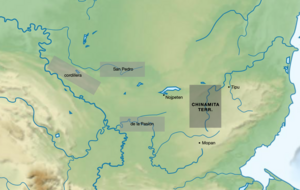Chinamita Territory
Script error: No such module "AfC submission catcheck".
Territory of the Chinamita | |
|---|---|
| ca 16th cent–ca 1700 | |
 Location of the Chinamita Territory in the 17th century / most commonly accepted location in dark grey, with alternative ones in light grey / 2023 map based on scholarship / via Commons | |
| Status | Dissolved |
| Capital | Tulumki / likely |
| Common languages | Mopan Mayan / likely |
| Religion | Maya polytheism |
| Demonym(s) | Chinamita; Tulumki |
| Government | Confederacy of settlements with aristocratic and theocratic features / possibly |
| Historical era | Spanish to Precolonial / likely |
• Established | ca 16th cent |
• Disestablished | ca 1700 |
| Today part of | Belize / likely Guatemala / certain |
Founding and dissolution dates per Jones 1998, pp. 19-20 and Palka 2005, pp. 1-2. Capital per Rice & Rice 2009, p. 13 and Jones 1998, pp. 19-20. Common language per Rice & Rice 2009, pp. 12-13 and Jones 1998, pp. 20-21, though see Jones 1977, p. 13 for dissent. Demonym per Rice & Rice 2009, p. 13 and Jones 1998, pp. 20-21, 433-434. Government per Jones 1998, pp. 20-22. | |
The Chinamita Territory is thought to have been an early Columbian polity of the former Maya Lowlands, in present-day Belize and Guatemala. Little is currently known of the Territory, though it is presumed to have been subordinate to or to have formed part of the Mopan Territory.
Background[edit]
The Territory is most commonly thought to have been situated in northeastern Guatemala and southwestern Belize, wedged between Nojpeten and Tipu, and to have thereby formed part of the Mopan Territory.[note 1] However, some scholars have proposed that the Territory rather lay in northwestern Guatemala.[note 2]
Itza–Chinamita relations are thought to have been quite strained, as the former are believed to have 'waged incessant wars against' the latter.[1][2][3]
As of 2009, the Territory and its residents remained 'virtually unknown materially and geopolitically except for documentary references or linguistic reconstructions.'[4][5]
See also[edit]
Notes and references[edit]
Explanatory footnotes[edit]
- ↑ Per Rice & Rice 2009, pp. 12-13, Cecil 2004, p. 387, Jones 1998, pp. 20, 22, and Simmons 1995, p. 144. However, Jones 1977, p. 13 notes that the aforementioned location of the Territory 'is surely incorrect; eastern and southeastern Petén, fully explored by the Spaniards [by 1697], contained no such group [ie no Chinamitas; m]oreover, moated and fenced strongholds [such as Tulumki] are typical of western, not eastern, Petén.'
- ↑ Caso Barrera 2006, first map, and para. 5 locates the Territory 'near the Xocmo River [ie Río de la Pasión],' while Spores 1986, p. 72 places it on Río San Pedro, and Jones 1977, p. 13 on the cordillera between the Usumacinta and San Pedro. Palka 2005, pp. 1-2 seems to place the Territory in northwestern Guatemala too, noting that by the early 18th century, at least some residents of the former Chinamita Territory were known to have settled on the Usumacinta. However, Jones 1998, p. 432 disagrees with all the aforementioned, noting they are 'surely incorrect in locating the Chinamitas southwest rather than east of Nojpeten.' Note Caso Barrera 2006, para. 5 further proposes the Territory formed part of the Xocmo Territory, whose residents were 'probably a dissident Itza faction established near the Xocmo River.' See Caso Barrera 2006, first map and Köhler & Esponda Jimeno 2004, p. 122 for identification of Xocmo River as Río de la Pasión.
Short citations[edit]
- ↑ Caso Barrera 2006, paras. 5, 7, 19.
- ↑ Jones 1998, pp. 19-21.
- ↑ Jones 1977, pp. 12-13.
- ↑ Rice & Rice 2009, p. 17.
- ↑ Jones 1977, p. 12.
Full citations[edit]
- Caso Barrera L (2006). "Guerre et factionnalisme entre les Itzaes durant la periode coloniale". Civilisations. 55: 52–69. ISSN 2032-0442.
- Cecil LG (August 2004). "Inductively coupled plasma emission spectroscopy and Postclassic Petén slipped pottery: an examination of pottery wares, social identity and trade". Archaeometry. 43 (3): 385–404. doi:10.1111/j.1475-4754.2004.00164.x.
- Jones GD, ed. (1977). Anthropology and History in Yucatán. The Texas Pan American Series. Austin, Tex. and London: University of Texas Press. ISBN 0292703147. OL 18272858W. Search this book on

- Jones GD (1998). The Conquest of the Last Maya Kingdom. Stanford, Calif.: Stanford University Press. ISBN 0804733171. Search this book on

- Köhler AM, Esponda Jimeno VM (2004). "Choles y chortíes de Karl Sapper, 1907". Liminar. 2 (1): 114–142. doi:10.29043/LIMINAR.V2I1.147.
- Palka J (Winter 2005). "Rock Paintings and Lacandon Maya Sacred Landscapes". The PARI Journal. V (3): 1–7. ISSN 1531-5398.
- Rice PM, Rice DS, eds. (2009). The Kowoj: Identity, Migration, and Geopolitics in Late Postclassic Petén, Guatemala. Mesoamerican Worlds. Boulder, Colo.: University Press of Colorado. ISBN 9780870819308. Search this book on

- Simmons SE (1995). "Maya Resistance, Maya Resolve: The Tools of Autonomy from Tipu, Belize". Ancient Mesoamerica. 6: 135–146. doi:10.1017/S0956536100002145.
- Spores R, ed. (1986). Ethnohistory. Supplement to the Handbook of Middle American Indians. 4. Austin, Tex.: University of Texas Press. ISBN 0292776047. OL 18331655W. Search this book on

External links[edit]
This article "Chinamita Territory" is from Wikipedia. The list of its authors can be seen in its historical and/or the page Edithistory:Chinamita Territory. Articles copied from Draft Namespace on Wikipedia could be seen on the Draft Namespace of Wikipedia and not main one.
